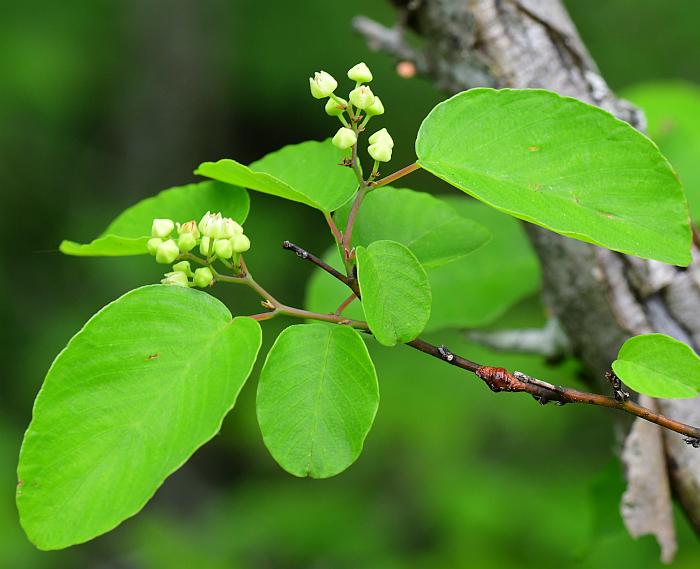Berchemia scandens (Hill) K. Koch
Alabama Supplejack

Native
CC = 6
CW = 0
MOC = 21
© SRTurner
Berchemia scandens (Hill) K. KochAlabama Supplejack | |
 |
Native CC = 6 CW = 0 MOC = 21 |
© SRTurner |
|
Family - Rhamnaceae Habit - Perennial liana, lacking tendrils. Stem - Stems to 30 m or more long, branched, twining, tough and flexible, the bark at first green and smooth, becoming gray or brown with age and developing fine, pale, longitudinal streaks as well as scattered, raised lenticels and branch scars in cross lines, the branches not spine-tipped. Twigs green to reddish brown, glabrous, the leaf scars mostly peglike, the winter buds small, ovate, flattened, with a few overlapping scales. Well-established plants may have stems up to 18 cm in diameter.
Leaves - Alternate, simple, short-petiolate. Blades 2-6 cm long, usually somewhat leathery, ovate, oval, or oblong to narrowly oblong, angled or rounded at the base, slightly tapered to a sharply pointed tip, the margins entire or slightly wavy, sometimes with scattered, minute, blunt teeth, the upper surface glabrous, green, shiny, the undersurface glabrous, pale green, not shiny, the venation pinnate with a single midvein and 8-12 pairs of lateral veins.
Inflorescences - Terminal and often also axillary, of loose clusters or small panicles.
Flowers - Apparently perfect but probably functionally staminate or pistillate. Hypanthium minute, 1-2 mm in diameter at fruiting. Sepals 5, 1-2 mm long, triangular. Petals 5, 1.0-1.5 mm long, greenish yellow. Stamens 5. Ovary 2-locular, the style short, unbranched. Fruits - Drupes 5-8 mm long, oblong-ellipsoid, with 2 stones, the outer surface thin, leathery, bluish black, glaucous. Flowering - May - June. Habitat - Glades, dry upland forest openings, bottomland forests, swamps, bases of bluffs, roadsides. Origin - Native to the U.S. Lookalikes - Species of Frangula or Rhamnus, such as Carolina buckthorn (F. caroliniana). Other info. - This vine occurs in the southern third of Missouri, its range extending from there southward and eastward throughout much of the southeastern continental U.S. It is remarkably suited to a wide range of moisture levels, from dry glades to swamps, though the most robust growth occurs in wet areas. A large plant can girdle and eventually kill the tree upon which it is twining. Young growth is tough and flexible and has been used for wickerwork. Photographs taken in vicinity of Shut-in Mountain fen complex, Shannon County, MO, 5-19-2023 (SRTurner). |